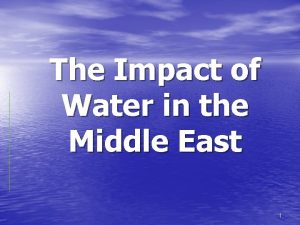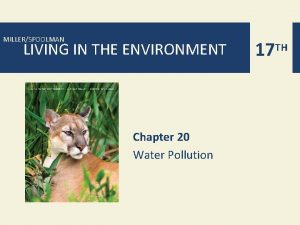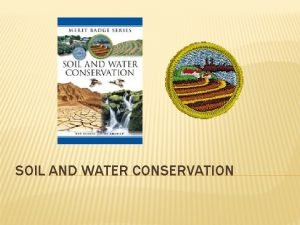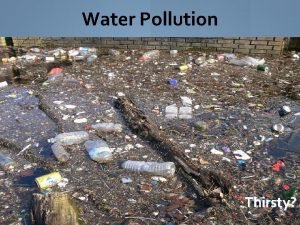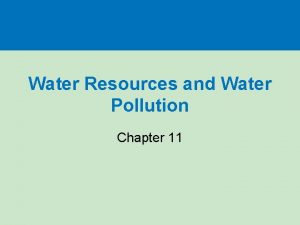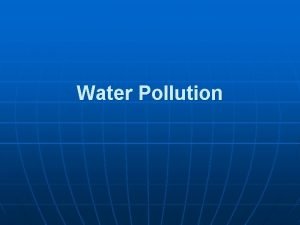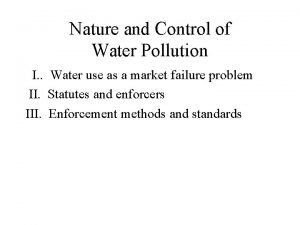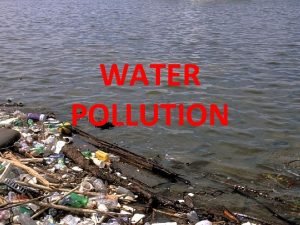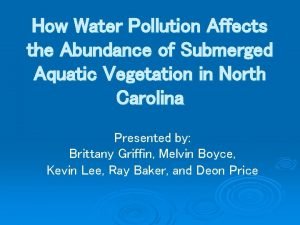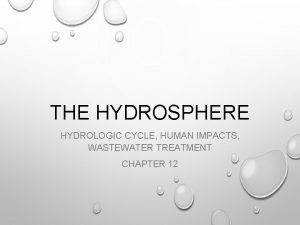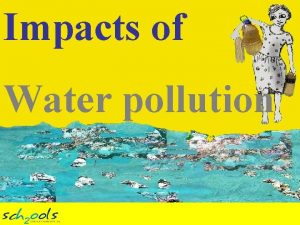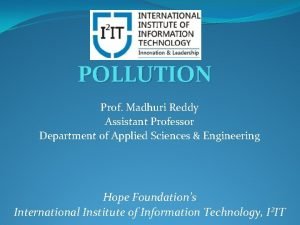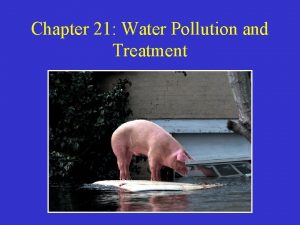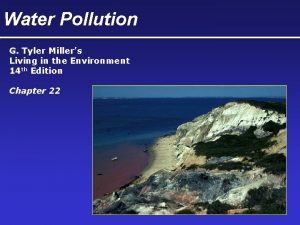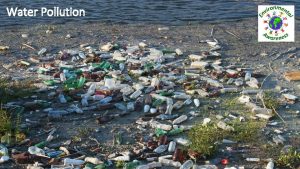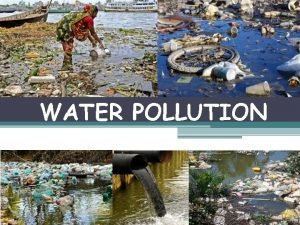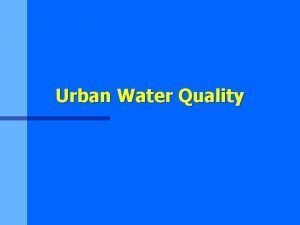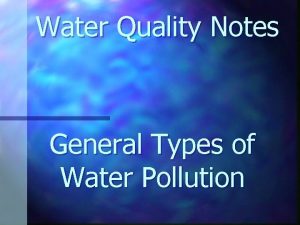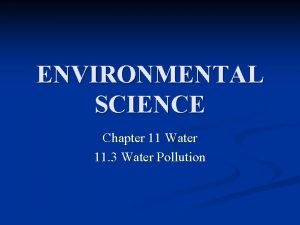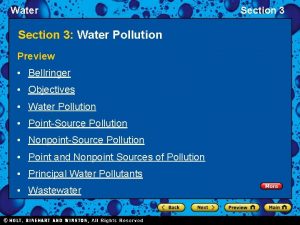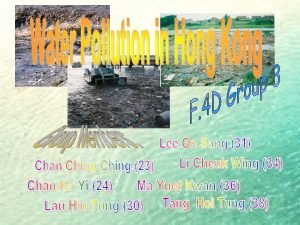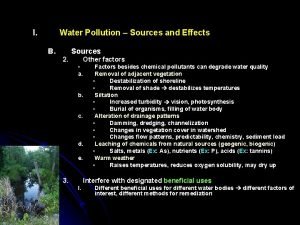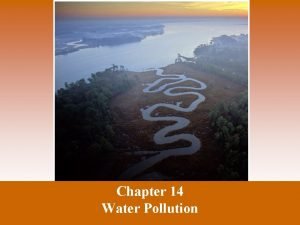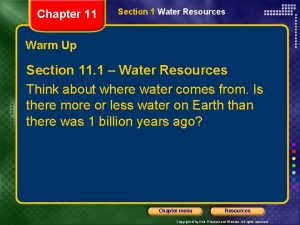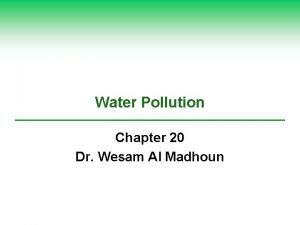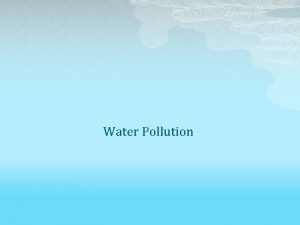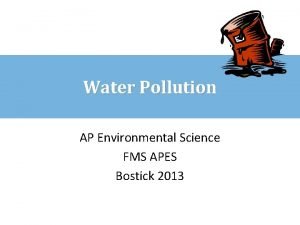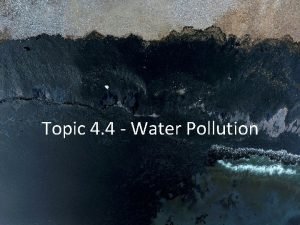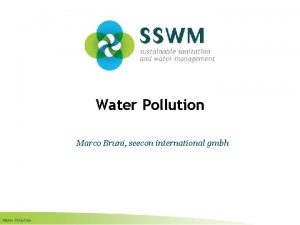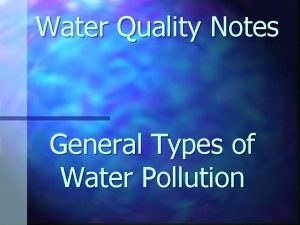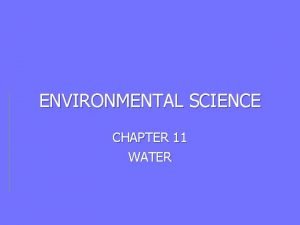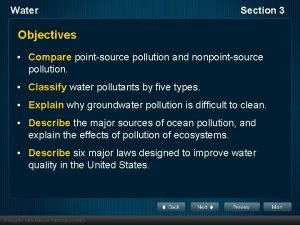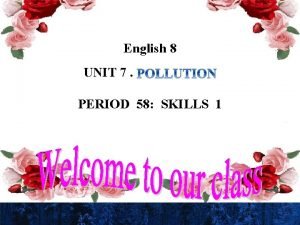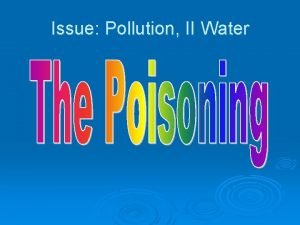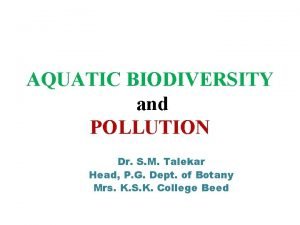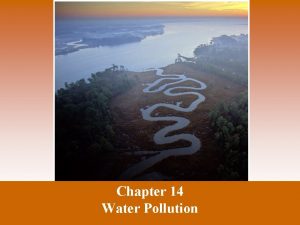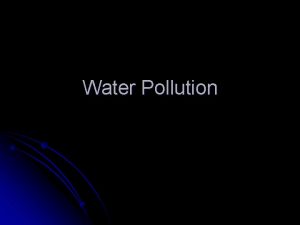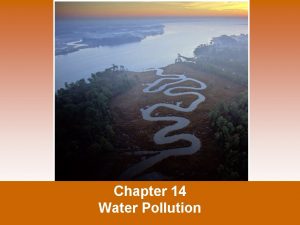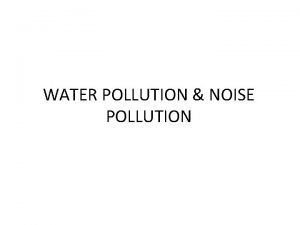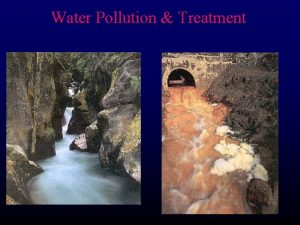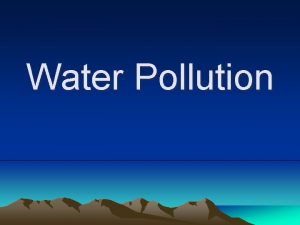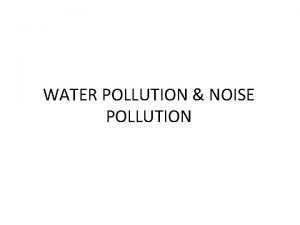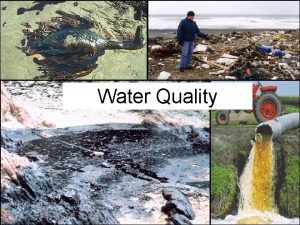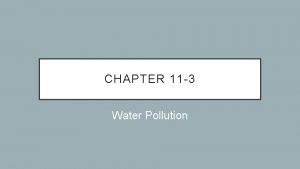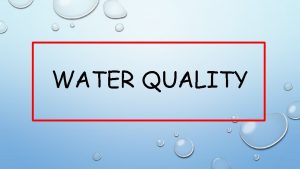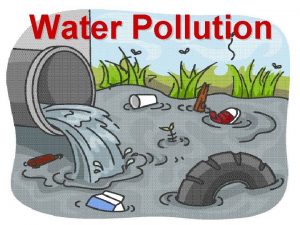Water Pollution 1 WATER POLLUTION n Water pollution














































- Slides: 46

Water Pollution 1

WATER POLLUTION n Water pollution- Any physical, biological, or chemical change in water quality that adversely affects living organisms • Point Sources n Factories, Power plants oil tankers • Non-Point Sources (runoff) n Agricultural fields, Feedlots 2

Types of Pollution n Disease-causing n Agents – pathogens Oxygen Demanding Agents – organic waste: manure n Inorganic Plant Nutrients – nitrogen and phosphorus n Water-soluble Inorganic Chemicals – acids, toxic metals Organic Chemicals – oil, pesticides, detergents n Sediment or Suspended Material – erosion, soil n Water-soluble Radioactive Isotopes – radon n uranium 3

TYPES AND EFFECTS OF WATER POLLUTION n Infectious Agents- waterborne diseases Main source-untreated or improperly treated human and animal wastes n Effects-diseases n n typhoid fever, cholera, dysentery E. Coli Hepatitis A Norwolk virus Rotavirus 4

Oxygen Demanding Agents n n n Caused by bacteria Creates fish kills Sources of organic matter Natural inputs-- bogs, swamps, leaf litter, and vegetation aligning waterways. n Human inputs-- pulp and paper mills, meatpacking plants, food processing industries, and wastewater treatment plants. n Runoff from urban areas, agricultural areas, and feedlots. n 5

Fish Die 6

BOD Effects on Water Quality 7

Inorganic Plant Nutrients Phosphorus and nitrogen are the major concerns Sources: • Human, animal (e. g. , Hog Farms), and industrial waste • Storm water • Soil erosion • Excessive use of fertilizers for crops, lawns, and home gardens 8

Inorganic Plant Nutrients High nutrient concentrations can cause Eutrophication (“wellfed” in Greek) of water bodies Eutrophication-rapid increase in plant life. • Ex. Algae bloom • Blocks sunlight • Decomposition of dead plants consumes oxygen. • Low oxygen conditions may kill fish etc. • Aesthetics (color, clarity, smell) 9

Water Soluble: Inorganic Pollutants n Metals n Mercury, lead, cadmium, and nickel n Highly toxic n Absorbed into plant or animal tissue n Bioaccumulate n Main source: surface runoff, acid mine drainage, burning of fossil fuels, by-product of industry 10

Water Soluble: Inorganic Pollutants n Nonmetallic Salts n Toxic levels through irrigation and concentrated by evaporation n Leaching of road salts n Acids and Bases n By-products of industrial processes 11

Organic Chemicals n Main source: household cleansers, surface runoff from farms and yards, industry Improper disposal of industrial and household wastes. n Runoff of pesticides from high-use areas. n n Fields, roadsides, golf courses n Runoff from oil from roads 12

Pesticide Runoff 13

Sediment Examples-soil, silt n Major human sources-land erosion n Harmful effects n Reduce photosynthesis n Disrupt aquatic food webs n n Destroy spawning grounds of benthic species n Clog harbors and lakes 14

Radioactive Materials Radioactive isotopes of iodine, radon, uranium n Main source: nuclear and coal burning power plants, mining, nuclear weapon production n Effects: genetic mutations, birth defects, cancer 15

Thermal Pollution Lowers dissolved oxygen levels n Increase in temperature, even a few degrees, may significantly alter some aquatic ecosystems n n Human sources-water cooling of electric power plants 16

Surface Water Pollution n Rivers • n Easy targets for dumping of sewage and industrial wastes Lakes, reservoirs and ponds more vulnerable to contamination 17

Case Study: Great Lakes • Basin contains >95% of fresh surface water in U. S. and 20% of world • Severe cultural eutrophication in 1960 s (e. g. , Lake Erie) • $20 billion pollution–control program improved water quality since 1972 Fig. 12– 22 © Brooks/Cole Publishing Company / ITP Water Resources and Water Pollution by Paul Rich 18

Groundwater Pollution n n ½ the U. S. population, and 95% of rural residents, depend on aquifers Sources include: leaky septic tanks, fertilizers, pesticides, landfills, hazardous waste dumps, underground storage tanks Renewed slowly, such that pollution lingers for long periods of time Extremely difficult to cleanup; prevention of contamination more effective 19

Groundwater Pollution 20

Prevention of Groundwater Contamination Reduce sources of water pollution that feed into the aquifer n Monitor aquifers near landfills & underground storage tanks n Require leak detection devices for underground tanks n Banning disposal of hazardous wastes in deep wells and landfills n Storing hazardous wastes above ground n 21

Ocean Pollution § n n n ½ world's population lives within 100 km (60 miles) of oceans and 14 of 15 largest cities are coastal Approximately 80% of debris originates onshore and 20% from offshore sources. About 35% of U. S. municipal sewage discharged virtually untreated in ocean waters Estimated somewhere 3 and 6 million metric tons of oil are discharged into the world’s oceans. 22

Marine Impacts n n n Degrades the quality and health of our oceans and marine habitats Poses risks to human health and safety Harms marine life 23

n n n n Main Types of Ocean Pollution Petroleum (oil) Sewage sludge DDT and PCBs n PCBs: used as liquid coolants, electrical equipment, insulation, etc. Mercury (industry)-Minamata Disease Marine Debris Point source (municipal and industrial facilities, oil tanker spills) Non-point source (material washed down storm drain: fertilizers, pesticides, oil, trash) 24 bss. sfsu. edu/ehines/geog 600/ Freshwater%20 and%20 ocean%20 Pollution. ppt

Ocean Pollution: Petroleum n Oil spills can be caused by: Tanker accidents n Intentional dumping n Drilling/ pumping operations n 25

Effects of Oil Spills • VOCs immediately kill plankton and larvae • Floating oil • Heavy oil sinks • Oil slicks on beaches © Brooks/Cole Publishing Company / ITP Water Resources and Water Pollution by Paul Rich 26

Marine Debris n Transported by currents on the surface or in the water column… n Other debris sinks and remains on the sea floor. 27

How Marine Debris Affects Marine Life Entanglement n Ingestion n Smothering n 28

Pollution in Coastal Waters n Highly affected by pollution: n Heavily used n Close to sources of pollution n Shallow-water bodies n Not as well circulated as the open ocean bss. sfsu. edu/ehines/geog 600/ Freshwater%20 and%20 ocean%20 Pollution. ppt 29

Case Study: Chesapeake Bay • Largest estuary in U. S. • Severely degraded by water pollution from 6 states • Deposition of air pollutants Fig. 12– 24 © Brooks/Cole Publishing Company / ITP Water Resources and Water Pollution by Paul Rich 30

Surface Water Pollution Control n n Soil conservation methods Applying only needed amounts of fertilizers, water, pesticides; apply only during certain times of the year Preserving wetlands (natural filters) Reduce materials carried away by storm runoff 31

Drinking Water Quality • Most drinking water is purified by storage in reservoir (suspended matter settles), and treated by sand filters, activated charcoal, and addition of chlorine • EPA sets Maximum Contaminant Levels for drinking water • Standards for numerous contaminants • immediate health threat if exceeded • Coliform bacteria • Nitrate - can cause ‘blue baby syndrome” 32

Municipal Water Purification Plant 33

So What Happens After We Flush? 34

Wastewater Treatment Objectives n Produce water suitable to return to aquatic environment n Removing physical, chemical, and biological In some cases, wastewater can be clean enough for reuse for particular purposes. n Mimics purification system of natural aquatic system n n faster and controlled 35 isis. csuhayward. edu/alss/Geography/ mlee/geog 4350/4350 c 4 f 01. ppt

Sewage or Wastewater Treatment n Sewage or wastewater is composed of sewage or wastewater from: n Domestic used water and toilet wastes n Rainwater n Industrial pretreated) effluent (Toxic industrial water is n Livestock wastes 36

Wastewater Treatment Types of treatment systems include: Septic Tanks or Wastewater Treatment Plants (WWTPs). • Septic Tanks • single household • WWTPs • Municipal or industrial waste. 37

Septic Tanks • Approx. 22 million systems in operation ( 30% of US) • Suitability determined by soil type, depth to water table, depth to bedrock and topography • Commonly fail due to poor soil drainage • Potential contaminants: bacteria, heavy metals, nutrients, synthetic organic chemicals 38

Municipal Sewage Treatment n Primary Treatment n Large debris filtered out by screens and grates n Solids waste (sludge) settles to bottom of tank 39

Municipal Sewage Treatment n Secondary Treatment - Aeration n n Effluent from primary treatment goes through aeration tank n Goal is to break down 85 -90% of organic matter and convert to carbon dioxide and inorganic nutrients n Bacteria degrade organic materials n Settled particles added to sludge Sludge from primary and secondary treatment is sent to landfill, burned or used for fertilizer 40

41

42

Municipal Sewage Treatment n n Tertiary Treatment - Removal of plant nutrients (nitrates and phosphates) from secondary effluent. Disinfection-removal of pathogens n n n Chlorination Ozone UV rays Treated water is discharged to waterways Used for irrigation 43

Water Pollution Legislation n Clean Water Act n Federal Water Pollution Control Act 1948 expanded into CWA 1972 n Set the basic structure for regulating discharges of pollutants in the water n Gave EPA the authority to set water quality standards for industry and for all contaminants in surface waters n EPA and state governments to issue permits to control how much pollution industries can discharge 44 Environmental Science ENSC 2800 - Pollution in the Bay-Delta

Water Pollution Legislation Safe Drinking Water Act, 1974, amended 1996 • • • Ocean Dumping Ban Act 1988 • • • Aims to ensure that drinking water is safe from source to tap Sets national standards for drinking water in both surface and groundwater Regulates intentional disposal of materials into oceans Oil Pollution Act (OPA) • 45 Establishes liability for oil spills; establishes fund to bss. sfsu. edu/ehines/geog 600/ Freshwater%20 and%20 ocean%20 Pollution. ppt

46
 Water and water and water water
Water and water and water water Why is water pollution a great concern in southwest asia
Why is water pollution a great concern in southwest asia Middle east
Middle east Methods to control water pollution
Methods to control water pollution Soil conservation project
Soil conservation project Non-point source pollution
Non-point source pollution Thermal pollution
Thermal pollution Solution to prevent water pollution
Solution to prevent water pollution N
N Water pollution theory
Water pollution theory Pollution of water is responsible for
Pollution of water is responsible for Control measures of water pollution ppt
Control measures of water pollution ppt Soil pollution effects on human health
Soil pollution effects on human health Conclusion of water pollution
Conclusion of water pollution Summary of water pollution
Summary of water pollution Groundwater pollution
Groundwater pollution Water pollution conclusion
Water pollution conclusion Effects of water pollution
Effects of water pollution Water pollution information
Water pollution information Introduction of water pollution
Introduction of water pollution What are the terrible twelve water pollution
What are the terrible twelve water pollution Conclusion of water pollution
Conclusion of water pollution Why is water pollution of great concern in southwest asia
Why is water pollution of great concern in southwest asia Water pollution introduction
Water pollution introduction Water pollution
Water pollution High level of pollution
High level of pollution Controlling measures of noise pollution
Controlling measures of noise pollution Wastewater sludge
Wastewater sludge Section 3 water pollution
Section 3 water pollution Water pollution conclusion
Water pollution conclusion Water pollution in hong kong
Water pollution in hong kong Ddt water pollution
Ddt water pollution Water pollution
Water pollution Chapter 11 section 3 water pollution
Chapter 11 section 3 water pollution Solutions to water pollution
Solutions to water pollution Types of water pollution
Types of water pollution Tertiary treatment apes
Tertiary treatment apes Land water and air pollution
Land water and air pollution Direct water pollution
Direct water pollution Pollution of water is responsible for
Pollution of water is responsible for Water pollution through the years
Water pollution through the years Water that contains waste from industry or homes
Water that contains waste from industry or homes Objectives of water pollution
Objectives of water pollution 8 effects of water pollution
8 effects of water pollution What is water pollution?
What is water pollution? What are 5 effects of water pollution?
What are 5 effects of water pollution? Water pollution
Water pollution


